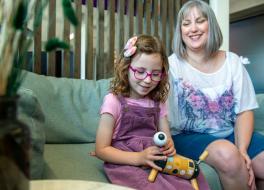

Children's Stammering Options Explained
Find out what to expect from speech & language therapy for children and teenagers. Learn about other courses available for stammering.
Before going on, have you read Help If Your Child Stammers? It's got lots of tips for supporting your child if they start stammering.
On this page we'll tell you more about the things listed on Children's Stammering Therapy & Courses. You can learn how they aim to help and what to expect.
On this page:
Managing expectations
Speech & language therapy
Non-therapy courses
Chat with us if you'd like to talk things through. Call our free helpline on 0808 802 0002, start a webchat or email help@stamma.org
(Is your child is having therapy but you don't think it's going well? See What To Do If Child Therapy Isn't Working Out.)
Managing expectations
Before going on, it's important to note that there is no 'quick fix' for stammering. None of the options can cure or stop stammering.
But support from therapy or a course can help to make your child feel confident about talking.
For more information, see Is There a Stammering Cure?.
Speech & language therapy
For some children, stammering will eventually go. Other children might continue to stammer. But there are many ways a speech & language therapist, either NHS or private, can support you and your child.
Therapy can help children to:
- feel good about talking, stammering and themselves
- become a confident and effective communicator.
Every child and every family is different. Your therapist will work closely with you to agree the goals of any therapy. They will then tailor the support they offer to you and your child depending on what you need.
A speech & language therapist may:
- Explain stammering so it feels less worrying. They'll tell you how speech is produced and what happens when someone stammers.
- Find out what affects your child's stammering. They'll help you feel confident in supporting your child at home, at school and socially.
- Address the emotional side of things for you and your child. This can help to deal with difficult thoughts and feelings around stammering. You might discuss strategies to cope with bullying or teasing.
- Help to develop general language and communication skills. Good communication doesn't mean fluency. It includes skills like listening, eye-contact and taking turns.
- Work with others to create a positive environment around your child. This can include other family members, nursery staff or childminders.
- They might even support teachers in talking to the class about stammering. This might help if your child is being teased or has experienced unhelpful responses.
- Help your child reduce avoidance. Therapists may support them to try words or situations they might be fearful of.
- Make speech changes. If appropriate, a therapist may help your child explore different ways of speaking. This can help them to say what they want to say more easily.
Being involved in your child's therapy
Therapy is likely to include some work with you or your family as a whole. Making changes to how the family communicates may be helpful for your child. For example, working on taking turns to talk and reducing interruptions.
Therapy might involve 'homework' that you'll be asked to help your child with. Don't worry, this will usually include games to make it fun for your child.
Group speech & language therapy
An alternative to one-to-one therapy for children is a short intensive group course.
Your local NHS service may run groups as part of their support for children who stammer. These can be either during term time or in the school holidays. But not all services provide them.
Across the country there are also stammering therapy courses available. They're not always free and there aren't many courses around so you might have to travel to go to them.
Courses are usually held in small groups with children of a similar age. One course at City University involves parents too. The Fluency Trust and Talking Out combine therapy with outward bound activities. These are residential courses for up to five days.
These stammering therapy courses, run by qualified speech & language therapists, can:
- help children become less bothered about stammering
- help reduce negative effects on their life
- develop communication skills and confidence in social situations or giving presentations.
Non-therapy courses (for older children)
The courses mentioned above are run by speech & language therapists. There are some that are led by people with experience of stammering instead.
For example, The Starfish Project runs an annual course for children aged 11-16. Instead of therapists, it is facilitated by adults who have done the course before.
On the Starfish Project course, students learn a technique which they call 'costal breathing'. They also call it 'diaphragmatic retraining'.
With this, you learn a new way of breathing at the beginning of words or phrases. The course also includes desensitisation exercises that aim to increase confidence.
- This is taught on short, intensive group courses.
- Courses are held over three days.
- They're normally at hotels, with children and accompanying parents staying for the duration.
- Children will practise the technique one-to-one with returning adult graduates.
- Courses are intensive, with students starting in the morning and working until late afternoon/early evening.
- Like some therapy courses above, The Starfish Project course costs money. But it's a one-off fee and you can return as many times as you want.
- The Starfish Project has a well-established support network.
More support & information
- Are you wondering what to expect from a first appointment with a speech & language therapist? See Children's Stammering Therapy: First Visit.
- Join our Parent2Parent Online Support Groups.
- Join one our Workshops.
- See our Videos For Parents.
- If you don't think therapy or a course is going well, see What To Do If Child Therapy Isn't Working Out.
Did you find this page helpful? Give us your feedback. We'd love to hear from you.
Find out How We Produce Our Information.
Become A STAMMA Member for free and join the community.
See other ways you can get involved with the STAMMA community. Find an event, fundraise, share your story, take part in research and much more.



































